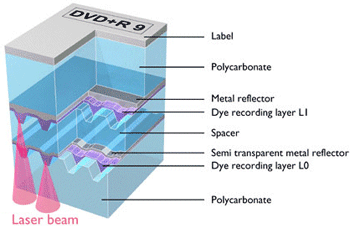 Dual-layer DVD media can store 8.4GB of data,
which is approximately twice that of its single-layer counterparts capacity of
4.7GB. This is because Dual Layer DVD media has two dye layers for data
recording. Heat caused by the drive's laser beam modifies the physical and
chemical structure of each dye layer to form patterns which can be read by the
same laser (at a lower intensity) as digital data.
Dual-layer DVD media can store 8.4GB of data,
which is approximately twice that of its single-layer counterparts capacity of
4.7GB. This is because Dual Layer DVD media has two dye layers for data
recording. Heat caused by the drive's laser beam modifies the physical and
chemical structure of each dye layer to form patterns which can be read by the
same laser (at a lower intensity) as digital data.
Each dye
layer is separated by a spacer and a metal reflector. The metal layer
reflects the laser light, allowing the drive to 'read' the data by observing the
reflections. The first reflector (positioned after the first dye layer) is semi-transparent; when the
laser is focused a certain way, it will pass through this reflector and continue
through to the second dye layer and bounce off the second metal
reflector.
This allows the drive to read the second
layer of data. The second reflector is completely opaque and will not allow the
laser beam to pass any further. Thus, by modulating the frequency of its laser
beam, a dual-layer capable DVD-writer can read and write to dual-layer DVD
discs.
There are a couple of ways to
indicate dual-layer media. The most common is 'DVD+R DL' but it's also sometimes
indicated as DVD+R9. Obviously, both the drive and the media need to be dual-layer capable
in order to access the extra storage space afforded by these
8.4GB optical discs!
The LG
GSA-H62N DVD writer is compatible with DVD-/+R Dual Layer media at
up to 10x write speeds.
Prelude to Benchmarks
The details of how the LG GSA-H62N dual layer SATA
DVD burner was configured for benchmarking, including the specific hardware,
software drivers, operating system and benchmark versions are indicated below.
The general specs for the reference platforms are the same. Please take a
moment to look over PCSTATS test system configurations before moving on to the
individual benchmark results.
 |
| PCSTATS Test System Specs: |
|
|
 CD Winbench 99
CD Winbench 99 |
Source: Zdnet |
The CD Winbench99 benchmark runs a series of
scripted programs from a special CD in the drive and measures the speed of the
data transfer. Higher numbers mean better performance.
The LG GSA-H62N writer is one of the fastest drives in terms of throughput. In the
grand scheme of things, the differences are very small and it won't really make playing a CD a better
experience.
 SiSoft Sandra 2005
SiSoft Sandra 2005 |
Source: Sandra |
Sandra is designed to test the theoretical power of
a complete system as well as the individual components. The results are also
purely theoretical and may not represent real world performance.
|
Sisoft
Sandra 2005 Benchmark Results |
|
Optical Drive |
LG
GSA-H62N |
AOpen DSW1812P |
Samsung WriteMaster SE-W164 |
Gigabyte GO-W1616A |
MSI DR16-B |
AOpen DRW8800 |
AOpen 5232 Combo |
LG GSA-4082B |
| Disc Type |
Data |
Data |
Data |
Data |
Data |
Data |
Data |
Data |
| Drive Index |
3785 kb/s |
3495 kb/s |
3005 kb/s |
3041 kb/s |
2912 kb/s |
3056 kb/s |
2574 |
1627 |
| Buffered Read: |
3414 kb/s |
3040 kb/s |
2564 kb/s |
2345 kb/s |
2480 kb/s |
2567 kb/s |
6000 kb/s |
779 kb/s |
| Sequential Read: |
3983 kb/s |
3710 kb/s |
3140 kb/s |
3347 kb/s |
3135 kb/s |
3258 kb/s |
2712 kb/s |
2362 kb/s |
| Random Read: |
3357 kb/s |
3187 kb/s |
2802 kb/s |
2641 kb/s |
2577 kb/s |
2752 kb/s |
2336 kb/s |
524 kb/s |
| Access Time: |
243ms |
179ms |
157ms |
213ms |
283ms |
231ms |
220 ms |
761ms |
The LG GSA-H62N has a lot of bandwidth available to it, particularly when compared to the other optical drives
PCSTATS has tested. Access times are a bit on the high side, at 242ms, but nothing
too out of the ordinary.
